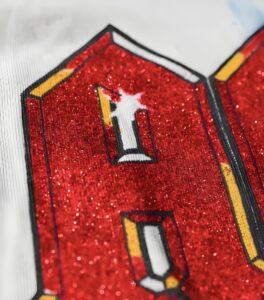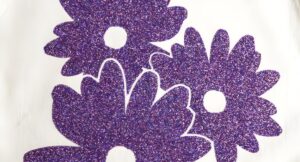1. What Makes Glitter & Metallic Screen Printing Unique?
Screen printing with glitter or metallic ink isn’t just about making fabric glittery—it’s about combining the tactile excitement of glitter flake or metallic shimmer with traditional ink to create unforgettable prints. Unlike standard plastisol ink or water-based ink, glitter and metallic inks contain particles (like metallic silver flakes, gold glitter, or colorful glitters) that reflect light and add texture.
These specialty inks require special handling. If you want to achieve an opaque, vibrant shimmer, the ink deposit must be thick enough to allow the flakes or metallic particles to be suspended above the fabric surface, maximizing reflection and shine. The results—when done properly—can include subtle shimmer effects, bold metallic statements, or a full-blown sparkle design that turns any shirt into a wearable work of art.
The process may sound daunting, but with the right techniques and attention to detail, printing with glitter becomes easy to use and endlessly creative. Glitter screen printing stands out in any apparel lineup, especially for custom fashion, spirit wear, and promotional gear.
2. How Does Glitter Ink Work in Screen Printing?
Glitter ink is specifically formulated for screen printing. At its core, glitter ink blends cosmetic-grade glitter flake into a base (often plastisol or synthetic resin). The ink’s viscosity suspends glitter so it doesn’t settle, ensuring an even distribution throughout the print.
When printed, the glitter ink adheres to the surface of the fabric, catching and reflecting ambient light. The result is a sparkling effect matched by few other printing techniques. Glitter plastisol, in particular, is easy to use, with particles that maintain their shimmer after the ink has cured.
Glitter ink isn’t limited to one color—manufacturers offer a rainbow of choices, as well as blends like silver glitter and gold glitter. Depending on the mesh count and type of screen printing ink used, you can create everything from fine, subtle glimmer to chunky, eye-popping sparkle.
3. What Is Plastisol Ink and Why Is It Preferred for Glitter?

4. Which Screens and Mesh Count Are Best for Glitter Prints?
5. How to Choose Between Silver Glitter, Gold Glitter
6. Preparing Your Design for Sparkling Impact
7. Step-by way of-Step: Printing With Glitter — Best Practices

Screen Preparation:
- First, choose your display with the best mesh depend. Coat your display with a like minded emulsion, reveal, and wash out your design photograph, making sure open areas for the ink deposit.
- Inking Up: Flood the screen with your selected glitter display printing ink—silver glitter, gold glitter, or coloured glitter. Use a soft squeegee for max coverage and observe even, firm stress.
- Printing: Pull the squeegee throughout the display easily, ensuring an excellent deposit. Multiple passes can be vital to build up the ink layer for heavy glitter, however check on a spare shirt or cloth.
- Flashing and Layering: If the use of as a part of a multi-layer layout, flash dry (brief, partial therapy) among layers to save you ink bleeding. For particularly bold sparkle, some printers upload an underbase in white or metal silver earlier than layering glitter ink.
8. How to Cure Glitter and Metallic Prints for Durability
Curing is vital in screen printing, but even more so when working with specialty inks like glitter or metallic silver. Both require higher heat and dwell time to cure completely, locking the ink (and all those precious flakes) onto the fabric.
Most glitter inks cure plastisol ink around 320°F (160°C), though specific manufacturer recommendations may vary. Use a conveyor dryer or heat press for an even, full cure across the garment. Be careful—over-curing can dull the glitter, while under-curing will lead to flaking or wash-out.
Way to test: After curing, stretch the print slightly. If the glitter or metallic ink cracks or peels, a longer cure or higher heat may be needed. A properly cured print will withstand successive washes, retaining its shimmer and color vibrancy.
9. Care & Wash Tips for Glitter-Printed Garments
To keep that beautiful sparkle and shine, follow proper care and wash protocol for your glitter and metallic screen prints. Glitter prints are robust if cured correctly, but rough wash cycles or harsh detergents can accelerate fading or lead to glitter loss from the fabric.
Advise your customers or end-users to turn garments inside out before washing, using cold water on a gentle cycle. Avoid bleach and strong chemical detergents, which can break down the ink and damage the glitter flakes. Whenever possible, air dry the shirt rather than using a hot dryer to extend both ink and garment life.
Screen printers who want high customer satisfaction should include care instructions with every shirt—this small step ensures your glitter screen printing remains dazzling for years.
10. Troubleshooting Common Glitter Screen Printing Issues
Even experienced screen printers can run into trouble when experimenting with glitter, metallic silver, or other specialty inks. Here are some common issues—and tips to solve them:
- Clogged Screen: If glitter flakes clog your mesh, you may be using too fine a mesh count or old emulsion.
- Patchy Glitter Deposit: This could indicate uneven squeegee pressure or insufficient ink deposit—make sure your screen is flooded correctly.
- Glitter Flake Falling Off: Insufficient curing or incorrect temperature. Always double-check your conveyor or heat press settings, and cure plastisol ink for the recommended duration.
- Dull Sparkle or Shine: Over-curing or poor-quality glitter ink may dull the shimmer. Try a different brand or tweak your curing time.
For best results, always test new ink and mesh combinations before full production, and keep diligent notes on what works for your garment, fabric, and design needs.
Key Takeaways: Glitter & Metallic Screen Printing Mastery
- Glitter and metallic inks add sparkle, shimmer, and WOW factor to any screen printed garment.
- Use plastisol ink for suspending glitter flakes, ensuring even, high quality prints.
- Choose appropriate mesh count (24-43 for glitter, higher for metallic inks).
- Silver glitter, gold glitter, and metallic inks provide distinct visual effects—pick the right one for your design and fabric color.
- Prepare designs with bold, open areas for best sparkle.
- Always flood the screen and apply even squeegee pressure to ensure optimal ink deposit.
- Cure plastisol ink at the manufacturer’s recommended temperature for maximum durability—test your print before a production run.
- Advise gentle care and wash procedures to preserve the ink and glitter sparkle.
- Troubleshoot screen, mesh, and ink issues early to avoid wasted garments.
- With attention to technique and detail, glitter screen printing ink is easy to use and can transform your shirts and fabrics into standout creations.
Ready to bring dazzle to your next printing project? Grab your glitter ink and make your screen print truly sparkle!
